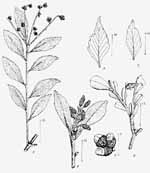|
|
|

"A-B. types of phyllodia, C-D. fruiting branch, E. branch with male catkins, F. fruits enlarged" (3). |
Phyllocladus hypophyllus
Hooker 1852
Common NamesCelery top pine (2).
Taxonomic notesSyn: P. hypophyllus Hooker var. protracta Warburg 1900; P. protractus (Warburg) Pilger 1903; P. major Pilger 1916. Holotype from Mt Kinabalu, Borneo (3).
Description"Trees up to 30 m, or stunted treelet, 2-3 m high, bole up to 8 m, d.b.h. up to 60 cm, crown fairly wide spreading. Bark black, dark brown, or grey, smooth and not peeling or scaly and rough, often with large pustular lenticels. Inner bark pink or brown, with little orange Milky exudate, weakly fibrous. Sapwood light brown, yellowish red, white. Wood light brown, orange brown or brown, very hard, fragrant. Branches more or less whorled around main stem, much branched. Foliar buds enclosed by thin bracts. Phylloclads dark green or yellowish green above and glossy, underside lighter, sometimes glaucous, variable in shape, elliptic to triangular, or cuneate, 3-7 by 1-5 cm, deeply lobed to almost entire along apical margin. Male inflorescence yellow when young, mature ones red or pink, catkin cylindric, 10-15 by 2-3 mm, microsporophylls oblong or squamiform, 1-2 by 1-1.5 mm, acute. Pedicels 5-15 mm long. Peduncle 3-10 mm long. Female cones light green, reddish brown, or dark brown, clustered on an 8-12 mm long peduncle, or terminal on a slightly modified phylloclad, with 1-3 fertile scales" (3).
RangeE Malaysia, E India, Philippines, Papua New Guinea, 900-4000m (1). Alternatively, Luzon, Borneo, New Guinea, and Goodenough Island (3). Require more information to resolve this contradiction.In New Guinea, it is "A widespread and commmon species from the upper lowland forests to the subalpine shrubberies, rarely as a solitary tree in the alpine grasslands, 900-3600 m. Flowers the whole year round depending on local conditions" (3).
Big Tree
Oldest
DendrochronologyNothing known as of December 1997.
Ethnobotany"The timber is used mainly for housebuilding purposes while the bark is regularly used for roofing" (3).
Observations
Remarks"A National Park at Mt. Giluwe in the Southern Highlands Province [of Papua New Guinea] is proposed, including a mountain region of considerable beauty and exceptional botanical interest. ... The Park should be extended to include areas of forest dominated by Nothofagus grandis and N. pollei , locally known as 'Karapeh karapeh' and 'Karapah pu', and areas dominated by celery top pine Phyllocladus hypophyllus . The area is very rich in plant and animal species, including an unnamed giant Water Rat and six other Rat species" (2).
Citations(1) Silba 1986 .(2) Filer 1991 . (3) Van Royen 1979 . (4) de Laubenfels 1988 . |
|
[ Phyllocladus ] [ Podocarpceae ] [ home ]
This page is from the Gymnosperm Database
|